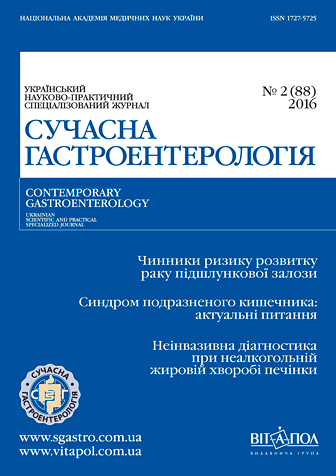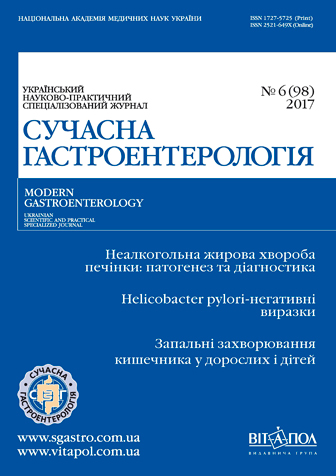- Issues
- About the Journal
- News
- Cooperation
- Contact Info
Issue. Articles
¹2(88) // 2016

1. Original researches
|
Notice: Undefined index: pict in /home/vitapol/sgastro.vitapol.com.ua/en/svizhij_nomer.php on line 74 The peculiarities of eating behaviour in patients with nonalcoholic steaohaepatites with obesity and arterial hypertensionG. D. Fadieienko, Yà. V. NikiforovaSI «L.T. Mala National Therapy Institute of NAMS of Ukraine», Kharkiv |
|---|
Materials and methods. The study involved 80 NASH patients, aged 33 — 60 years (mean age 50.38 ± 9.48 years), admitted in the Department of Gastroenterology of the L. T. Mala National Therapy Institute of NAMS of Ukraine. The comparison group consisted of 30 healthy subjects. No serum markers of viral  and Ñ hepatitis, autoimmune and hereditary liver diseases were detected in the investigated subjects. The EB type (external, emotiogenic, restrictive) was defined with the questionnaire DEBQ (the Dutch Eating Behavior Questionnaire, T. Van Strien, A. J. Strunkard, 1986). NS was investigated with the use of questionnaire, specially elaborated for this study, and on the basis of analysis of the nutritional diary. The excessive body mass and obesity was assed based on the anthropometric parameters. All patients were undergone measurements with calipers and 24-hours arterial pressure monitoring with the use of portative monitor (ÀÂÐÌ-02Ì, Meditech). The carbohydrate exchange was assessed by fasting glucose and glycated hemoglobin levels (if indicated). Lipid profile and blood uric acid levels were assessed with immune-enzymatic analysis. The hepatobilliary status was investigated with the ultrasonic diagnostic system Phillips IU.
Results. The external eating behaviour prevailed in NASH patients with obesity and arterial hypertension (52.5 % of cases; p < 0.05), the restrictive type was in 25 % of patients, emotiogenic in 22.5 %. The external type was predominant in men (p < 0.05), while women demonstrated different types of eating behaviour insignificant prevalence of emotiogenic type. The external eating behaviour prevailed in all age-related groups.
Conclusions. Patients with patients with nonalcoholic steaohaepatites with obesity and arterial hypertension demonstrated the disorders in carbohydrate and lipid exchange: progression of insulin resistance and increase of proatherogenic lipid fractions, obesity, including its abdominal form. The predominance of external eating behaviour was established (p < 0.05). The correction of eating behaviour and nutritional status in these patients can be applied for both the primary and secondary prophylaxis.
Keywords: nonalcoholic steatohepatitis, eating behaviour, nutritional status, obesity, arterial hypertension.
![]() To download
To download
full version need login
Original language: Ukrainian
2. Original researches
|
Notice: Undefined index: pict in /home/vitapol/sgastro.vitapol.com.ua/en/svizhij_nomer.php on line 74 Therapeutic strategy in patients with non-alcoholic fatty liver disease, considering cytokeratin-18 level determination in blood plasmaO. Ya. Babak, Ê. À. LapshynaKharkiv National Medical University |
|---|
Materials and methods. The study involved 30 patients with NAFLD in NASH stage. The mean age of the patients was 47.6 ± 3.7 years, from them 16 (53 %) men and 14 (47 %) women. All patients were diagnosed with NAFLD in NASH stage, The investigations included routine clinical and laboratory methods, assessments of tophological status and lipid metabolism. Ther determination of CK-18 monoclonal antibody in blood plasma was performed. Analysis of the dynamics of biochemical parameters and the level of CK-18 was evaluated before and 30 days after the treatment. All patients received a combined therapy of ursodeoxycholic acid and ademetionine during one month.
Results. Evaluation of CK-18 level in the blood plasma of NAFLD patients in NASH stage before and after a month of treatment showed a significant decrease in the levels of CK-18 by 8.6 % (p < 0.05), cytolysis syndrome indicators: AST and ALT levels decreased in 2 and 2.4 times, respectively (p < 0.04). The lipid profile were normalized with total cholesterol, LDL and atherogenic ratio (p ≤ 0.05), TG, HDL and VLDL tended to decrease (p > 0.05).
Conclusions. The combined therapy of UDCA and ademetionine resulted in the decrease of CK-18 levels in blood plasma of NASH patients, reduction of cytolysis rates and normalization of the lipid profile, indicating the slowdown of disease progression.
Keywords: non-alcoholic fatty liver disease, cytokeratin-18, ursodeoxycholic acid, ademetionine.
![]() To download
To download
full version need login
Original language: Ukrainian
3. Original researches
|
Notice: Undefined index: pict in /home/vitapol/sgastro.vitapol.com.ua/en/svizhij_nomer.php on line 74 Dynamics of adiponectin, inflammatory cytokines, and some metabolic parameters in patients with nonalcoholic fatty liver disease and hypertension, treated with the combined therapyK. Î. Prosolenko
|
|---|
Materials and methods. The study involved 88 patients with NAFLD with hypertension stage II, 2 degree, treated in L. T. Mala National Therapy Institute of NAMS of Ukraine, form them 49 (55.68 %) men and 39 (44.32 %) females; the mean age was 51.3 ± 6.2 years. The control group consisted of 30 age and gender matched healthy volunteers. The examinations included indices of lipid and carbohydrate metabolism, blood pressure, adiponectin and pro-inflammatory cytokines (TNF-α and IL-6) by conventional methods. Ultrasound examinations of liver and other gastrointestinal organs were performed. Patients with NAFLD and hypertension (n = 88) were divided into two groups. Patients of group I (n = 44) received lisinopril 10 mg/day, atorvastatin 10 — 20 mg/day. Group II patients (n = 44) received lisinopril 10 mg/day atorvastatin and 10 — 20 mg/day in combination with omega-3 fatty acids 2 g/d and UDCA 10 mg/kg/day. Duration of treatment was 12 months. All were given recommendations for a balanced diet and exercises.
Results. The patients with NAFLD and hypertension demonstrated abnormalitis of lipid and carbohydrate metabolism, increase of pro-inflammatory cytokines (TNF-α and IL-6) and decrease of adiponectin levels. The metabolic profile was worse in patients with NAFLD and hypertension, combined with obesity. As a result of the study, the significantly better improvements were achieved in group 2, in the case of administration of the complex therapy using UDCA and omega-3 fatty acids. In these group of patients, adiponectin levels increased by 47.57 % vs. 20.67 % in group 1 (p < 0.001).
Conclusions. The combined therapy, including atorvastatin, lisinopril, UDCA and omega-3 fatty acids in combination with non-drug therapy, proved to be more effective for patients with NAFLD and hypertension in comparison with the treatment scheme, which included lisinopril and atorvastatin combination with non-drug therapy, in terms of correction of the metabolic disorders, associated with NAFLD. It resulted in the reduction the overall cardiometabolic risk and improvement of life prognosis in patients with NAFLD and hypertension.
Keywords: non-alcoholic fatty liver disease, hypertension, adiponectin, proinflammatory factors.
![]() To download
To download
full version need login
Original language: Ukrainian
4. MEDICINES
|
Notice: Undefined index: pict in /home/vitapol/sgastro.vitapol.com.ua/en/svizhij_nomer.php on line 74 Effects of the bile acid preparations on the lipid exchange in patients with the postcholecystectomy syndromeG. A. Anoknina, V. V. KharchenkoP. L. Shupyk National Medical Academy îf Postgraduate Education of Health Ministry of Ukraine, Kyiv |
|---|
Materials and methods. The investigation involved 46 patients with PCES and 21 healthy volunteers. The age of patients was 38 to 65 years; women prevailed among these patients: 35 (76.1 %). The examinations included general clinical investigations, body mass index, waist circumflex, esophagogastroduodenoscopy, abdomen ultrasonic examinations, multiphase duodenal intubation with the definition of the time of Oddi sphincter of opening, volume and rate of the choledochic bile portion excretion, bacteriologic investigation of the choledochic and hepatic bile portions. The blood lipid and glucose levels were measured, as well as the biochemical parameters of hepatic function. The patients were divided into two groups depending on the treatments: the main group (n = 23) and comparison group (n = 23). Patients of both groups were administered the individual diet with restriction of simple carbohydrates, fats and high protein proportion. The patients of main group were additionally administered Choludexan in a dose of 900 mg/day.
Results. At baseline, the dyslipidemia was revealed in patients with PCES. After the treatment, attenuation of the signs of sonographic liver steatosis was observed. The positive dynamics was more expressed in patients of the main group. In this group, the portion of patients with the dilatated bile duct decreased. Thus, the size of the bile duct of 8 — 10 mm was revealed only in 8.7 % of patients. After the treatment, the positive dynamics of blood lipid levels was observed in patients of the main group. In particular, the blood levels of the high density lipoprotein cholesterol significantly increased in patients of the main group (in 1.2 times, ð < 0.01), whereas in patients of the comparison group, the trend toward the increase of this parameter was observed (the difference between these parameters before and after treatment wasn’t statistically significant).
Conclusions. The administration of the individual dietary treatment and ursodeoxycholic acid Choludexan preparation promoted the decrease of the sonographic signs of the liver steatosis, bile duct diameter, reduction of the blood levels of atherogenic lipids, and increase of the high density lipoprotein cholesterol levels.
Keywords: postcholecystectomy syndrome, lipids, bile duct, Choludexan.
![]() To download
To download
full version need login
Original language: Ukrainian
5. MEDICINES
|
Notice: Undefined index: pict in /home/vitapol/sgastro.vitapol.com.ua/en/svizhij_nomer.php on line 74 Rational choice of proton pump inhibitor for the treatment of chronic pancreatitis combined with drug-induced liver lesions. Part 2. Influence of treatment on the state of the pancreas and liver, metabolic homeostasis, quality of life of patients with comorbidityN. B. Gubergrits, P. G. Fomenko, O. Î. Golubova, N. V. ByelyayevaDonetsk National Medical University of Maxim Gorky, Lyman |
|---|
Keywords: chronic pancreatitis, drug-induced hepatitis, treatment, dynamics of the functional state and sonographic changes of the pancreas and liver, influence of treatment on metabolic indices, blood lipid profile, quality of life of patients.
![]() To download
To download
full version need login
Original language: Ukrainian
6. MEDICINES
|
Notice: Undefined index: pict in /home/vitapol/sgastro.vitapol.com.ua/en/svizhij_nomer.php on line 74 Clinical efficiency of the Progepar in the prevention progression of non-alcoholic fatty liver diseaseM. B. Shcherbinina1, E. V. Zakrevska2, N. P. Dementiy31 Oles Íonchar Dnipropetrovsk National University |
|---|
Materials and methods. The investigation involved 68 patients with NAFLD, 32 patients (12 men, 20 women) received the Progepar and the basic therapy (study group), and 36 patients (11 men, 25 women) received only the basic therapy (control group). The dynamics of clinical syndromes, liver enzymes (alanineaminotransferase, aspartateaminotransferase), sonographic parameters (size of the liver, the degree of steatosis) and the degree of fibrosis according to RTE-elastography of the liver were investigated.
Results. After 12 weeks from the treatment start, observations showed practically complete removal of clinical symptoms in the study group and trend the reduction of symptoms’ frequency in the comparison group. Positive dynamics of clinical symptoms was accompanied by a decrease in the activity of the inflammatory process in the liver tissue. This was followed by a decrease to normal alanineaminotransferase to 76.4 ± 14.6 to 28.8 ± 16.6 IU/L (p < 0.05) and aspartateaminotransferase to 51.5 ± 9.3 to 24.1 ± 7.7 IU/L (p < 0.05), the reduction of the livers’ size prior to treatment averaged 210.7 ± 25.4 mm, after treatment — 154.8 ± 11.1 mm (p < 0.05). Progepar marked positive impact on the regression degree of livers’ fibrosis and the degree of fatty livers’ infiltration. So, at the start 1 degree of hepatic steatosis was found in 13 patients (40.6 %), 2 degree — in 19 patients (59.4 %); Liver fibrosis: F0 — 4 patients (12.5 %), F1 — 15 (46.9 %), F2 — 9 patients (28.1 %), F3 — 4 (12.5 %). After 12 weeks therapy distribution degree of hepatic steatosis was as follows — 1 degree in 21 patients (65.6 %) and grade 2 in 11 patients (34.4 %); on the degree of livers’ fibrosis: F0 — 11 patients (34.4 %), F1 — 9 patients (28.1 %), F2 — 8 patients (25 %), F3 — 4 (12.5 %). In the comparison group, changes were observed in the downside performance of the morphological state of the liver.
Conclusions. Progepar contributes to improvement in both subjective clinical symptoms of NAFLD and objective indicators — reduces the activity of the cytolytic process in the liver, has a positive effect on the sonographic parameters reflecting the severity of steatosis and fibrosis of the liver, has a good tolerability profile and security. Such changes make a significant contribution to the prevention of disease progression. It lets us recommend Progepar for the treatment of NAFLD.
Keywords: Progepar, gidralizat calves liver, non-alcoholic fatty liver disease, liver steatosis, liver fibrosis.
![]() To download
To download
full version need login
Original language: Russian
7. MEDICINES
|
Notice: Undefined index: pict in /home/vitapol/sgastro.vitapol.com.ua/en/svizhij_nomer.php on line 74 The intestinal microbiota and metabolic syndrome: the unifying factorsO. V. KolesnikovaSI «L.T. Mala National Therapy Institute of NAMS of Ukraine», Kharkiv |
|---|
Keywords: metabolic syndrome, intestinal microbiota, Toll-like receptors, intestinal dysbiosis, metabolism, insulin resistance, dyslipidemia.
![]() To download
To download
full version need login
Original language: Ukrainian
8. MEDICINES
|
Notice: Undefined index: pict in /home/vitapol/sgastro.vitapol.com.ua/en/svizhij_nomer.php on line 74 Diagnostic opportunities for detection of pancreatic exocrine insufficiency and optimization of its treatmentO. V. ShvetsO. O. Bogomolets National Medical University, Kyiv |
|---|
Materials and methods. The open-labelled comparative study involved five patients with moderate pancreatic exocrine insufficiency (PEI) with average concentration of fecal pancreatic elastase 1 (FPE1) of 81.0 mcg/g and five patients with severe pancreatic exocrine insufficiency with average concentration of FPE1 of 37.4 mcg/g. All patients underwent 13MTBT twice: the first test was performed after intake of test meal with a tablet of Mezim forte 20 000 and the second one — after intake of one capsule of Pangrol 25 000 with a test meal.
Results. The cumulative concentration 13ÑÎ2 after 360 minutes of 13MTBT, which reflects the activity of pancreatic enzymes in the duodenal lumen, was used as parameter of estimation for PEI compensation by means of PERT (the norms is > 26.8 %). The intake of one tablet of Mezim forte 20 000 resulted in PEI compensation in all patients with moderate PEI, but only in 40 % of patients with severe PEI. The usage of one capsule of Pangrol 25 000 resulted in the normalization of the cumulative concentration 13ÑÎ2 after 360 minutes of 13MTBT in all patients with moderate and severe PEI.
Conclusions. The consecutive detection of FPE1 and conducting of 13MTBT is a rational approach to diagnosis of PEI and personalization of the PERT. Gastroresistant tablets Mezim forte 20 000 is economically acceptable and fairly affective PERT method for compensation of mild to moderate PEI. The administration of capsules with minitablets Pangrol 25 000 can be recommended for the patients with severe PEI. Depends on the residual excretory pancreas capacity and volume of meals ingested by a patient (the average dose is 25 000 — 50 000 IU per meal and 10 000 — 20 000 IU with snacks).
Keywords: pancreatic exocrine insufficiency, fecal pancreatic elastase 1, 13Ñ-mixed triglycerides breath test, pancreatic enzyme replacement therapy.
![]() To download
To download
full version need login
Original language: Ukrainian
9. MEDICINES
|
Notice: Undefined index: pict in /home/vitapol/sgastro.vitapol.com.ua/en/svizhij_nomer.php on line 74 Liver disease with cholestatic syndrome, gallbladder disease and ursodeoxycholic acid: new accentsM. B. ShcherbininaDnipropetrovsk National University named after Oles Honchar |
|---|
Keywords: cholestasis, primary biliary cirrhosis, primary sclerosing cholangitis, biliary sludge, Gilbert syndrome, ursodeoxycholic acid, ursotherapy.
![]() To download
To download
full version need login
Original language: Russian
10. Reviews
|
Notice: Undefined index: pict in /home/vitapol/sgastro.vitapol.com.ua/en/svizhij_nomer.php on line 74 Risk factors for pancreatic cancerG. D. Fadieienko, Î. G. KurinnaSI «L.T. Mala National Therapy Institute of NAMS of Ukraine», Kharkiv |
|---|
Keywords: pancreatic cancer, risk factors, nutrition, microelements, selenium.
![]() To download
To download
full version need login
Original language: Ukrainian
11. Reviews
|
Notice: Undefined index: pict in /home/vitapol/sgastro.vitapol.com.ua/en/svizhij_nomer.php on line 74 The role of the intestinal microbiota and diet at irritable bowel syndromeS. Ì. Tkach1, A. Å. Dorofeev2, G. K. Sizenko2, L. Ì. Kupchik21 Ukrainian Scientific and Practical Center of the Endocrine Surgery, |
|---|
Keywords: irritable bowel syndrome, intestinal microbiota, diet.
![]() To download
To download
full version need login
Original language: Russian
12. Reviews
|
Notice: Undefined index: pict in /home/vitapol/sgastro.vitapol.com.ua/en/svizhij_nomer.php on line 74 Noninvasive diagnosis of the degree of liver steatosis and fibrosis in patients with non-alcoholic fatty liver diseaseA. S. Svintsitskyy1, G. À. Solovyova1, N. V. Dynnyk1,V. M. Bogomaz1, O. M. Baka21 O. O. Bogomolets National Medical University, Kyiv |
|---|
Keywords: non-alcoholic fatty liver disease, non-alcoholic steatohepatitis, non-invasive biomarkers of liver steatosis and fibrosis.
![]() To download
To download
full version need login
Original language: Ukrainian
13. Reviews
|
Notice: Undefined index: pict in /home/vitapol/sgastro.vitapol.com.ua/en/svizhij_nomer.php on line 74 Irritable bowel syndrome: the difficulties in diagnosis and treatmentT. A. SolomentsevaSI «L. T. Mala National Therapy Institute of NAMS of Ukraine», Kharkiv |
|---|
Keywords: Irritable bowel syndrome, visceral sensitivity, microbiota, probiotics, antispasmodics, rifaximin.
![]() To download
To download
full version need login
Original language: Russian
Current Issue Highlights
¹6(98) // 2017

Chronic inflammatory bowel disease and viral infections
E. I. Sergienko
The phenomenon of Helicobacter pylori-negative ulcer and its place in clinical practice
V. ². Vdovychenko 1, Ya. B. Shvydkyi 1, A. V. Ostroglyad 2
Log In
Notice: Undefined variable: err in /home/vitapol/sgastro.vitapol.com.ua/blocks/news.php on line 51

